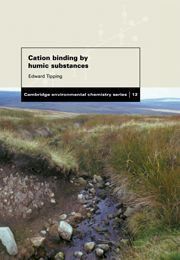Book contents
- Frontmatter
- Contents
- Preface
- 1 Introduction
- 2 Humic substances – a brief review
- 3 Environmental solution and surface chemistry
- 4 Proton dissociation from weak acids
- 5 Metal–ligand interactions
- 6 Methods for measuring cation binding by humic substances
- 7 Quantitative results with isolated humic substances
- 8 Cation binding sites in humic substances
- 9 Parameterised models of cation–humic interactions
- 10 Applications of comprehensive parameterised models
- 11 Predictive modelling
- 12 Cation–humic binding and other physico-chemical processes
- 13 Cation binding by humic substances in natural waters
- 14 Cation binding by humic substances in soils and sediments
- 15 Research needs
- References
- Index
10 - Applications of comprehensive parameterised models
Published online by Cambridge University Press: 18 August 2009
- Frontmatter
- Contents
- Preface
- 1 Introduction
- 2 Humic substances – a brief review
- 3 Environmental solution and surface chemistry
- 4 Proton dissociation from weak acids
- 5 Metal–ligand interactions
- 6 Methods for measuring cation binding by humic substances
- 7 Quantitative results with isolated humic substances
- 8 Cation binding sites in humic substances
- 9 Parameterised models of cation–humic interactions
- 10 Applications of comprehensive parameterised models
- 11 Predictive modelling
- 12 Cation–humic binding and other physico-chemical processes
- 13 Cation binding by humic substances in natural waters
- 14 Cation binding by humic substances in soils and sediments
- 15 Research needs
- References
- Index
Summary
The aims here are (a) to examine whether or not parameterised models can fit experimental data from laboratory experiments with isolated humic substances, (b) to discuss the meanings of the parameter values, and (c) to explore some of the predictions that the models can make. There is little point in considering applications of all the models discussed in Chapter 9. The simpler ones can fit data over small concentration ranges, or at a single pH, but their applicability is restricted. Therefore we shall confine our discussion to the models that might be able to fit most or all of the available data, and which can therefore be termed comprehensive models. Thus we shall just be examining the performances of Models V and VI and the NIC(C)A models.
Interactions with protons
Simulation of the dissociation of protons from humic substances is the first task for any model that purports to describe cation binding comprehensively. Figures 10.1 and 10.2 illustrate applications of Model V/VI and the NICCA–Donnan model to proton-binding data at different ionic strengths. Note that Models V and VI are identical in their descriptions of proton binding, and the same applies to the NICA and NICCA models. It can be seen that the models work well, reproducing the shapes of the curves and the ionic strength dependence. Generally, the NIC(C)A model provides superior fits, with smaller and more random residuals.
Information
- Type
- Chapter
- Information
- Cation Binding by Humic Substances , pp. 210 - 252Publisher: Cambridge University PressPrint publication year: 2002
